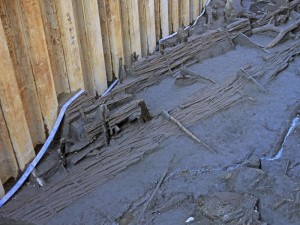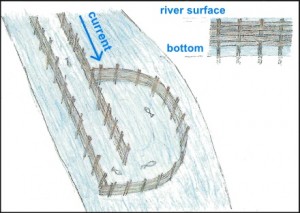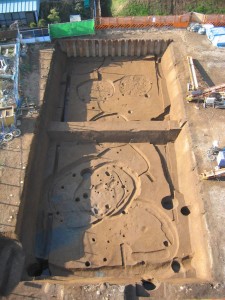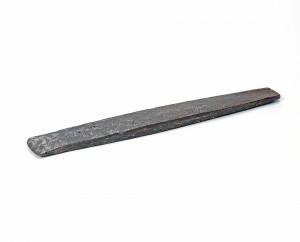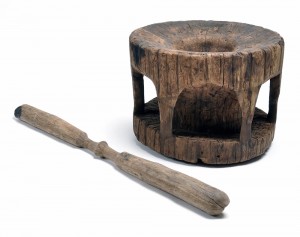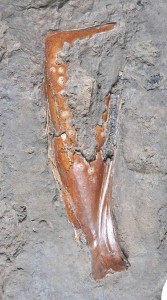The “weir-shaped feature” woven from bamboo-shaped materials as vertical and horizontal members. Built in a river in the Late Yayoi period, it is inferred to be part of a fishing facility.
Sketch of inferred reconstruction
Adapted from Hakkutsu sareta Nihon rettō 2016 [Excavations in the Japanese Archipelago, 2016] (Bunkachō [Agency for Cultural Affairs], ed., Kyodo News, 2016).
An image of the extent of the Yayoi period settlement and river
The settlement spread out following the greatly meandering river course. Active use of the river is assumed. Adapted from Hakkutsu sareta Nihon rettō 2016 [Excavations in the Japanese Archipelago, 2016] (Bunkachō [Agency for Cultural Affairs], ed., Kyodo News, 2016).
Panorama of the Yayoi period group of buildings
Nineteen structures were discovered within the narrow extent of 398 m2. The photo shows the overlapping condition of pit structures of the latter half of the Middle Yayoi period, and above these there were nearly the same number of overlapping buildings.
Recovered artifacts show the variety of work at the settlement
Small bronze bell (dōtaku)
Height: 8.1 cm; greatest width: 4.1 cm. Fins and surface designs are lacking. It is the third example of a dōtaku found within the prefecture.
Board-shaped iron axe
Length: 28.5 cm; width: 3.4 cm; thickness: 1.3 cm. A rare example that survived without rusting. The discovery of a board-shaped iron axe exceeding 20 cm in length is the first for eastern Japan.
Discoidal stone mace-head with handle
Diameter: 8–9 cm. A donut-shaped stone implement into which a wooden handle was inserted. As the wooden portion was recovered without having rotted away, it is a precious example showing in part the utilization of these stone implements.
Mortar and pestle
The mortar is 61.5 cm in diameter and 43.3 cm tall, and is in nearly complete form. The pestle is 121 cm long with a diameter of approximately 8 cm. Mortars of this period were for husking grain.
Oracle bone
Length: 19.7 cm. Divination was practiced based on how cracks formed when a deer scapula was roasted.
Kawaraguchi Bōjū Site, Ebina City, Kanagawa Prefecture
Middle–Late Yayoi periods (approximately 2,100–1,750 years ago)
A large-scale settlement of the Middle and Late Yayoi periods
Kawaraguchi Bōju is located in the city of Ebina in Kanagawa prefecture, situated atop a natural levee on the east bank of the Sagami river, which flows southward over the Sagami plain into Sagami bay.
While this is a composite site extending from the Yayoi to the Early Modern periods, a large-scale settlement was maintained here principally from the Middle to the Late Yayoi periods (approximately 2,100–1,750 years ago). From investigations conducted up to the present, the scale of the settlement is understood to have been been 410 m north–south by over 100 m east–west in extent. The principal features are pit structures, embedded-pillar buildings, square-shaped moated burial precincts, water storage features, and weir-shaped features (made of sticks and bamboo woven into the shape of a fence), and among these the pit structures reached more than 500 in number. In the 2006 fiscal year investigation, the discovery of a complete small bronze bell (dōtaku) drew attention as the third example of this item for the prefecture.
The variety of work at a riverside settlement
The river evidently meandered greatly as it flowed through the settlement. Its depth was more than 5 m, but from the Middle Yayoi to the Early Kofun periods it gradually filled in.
Weir-shaped features were found within the river. These were built atop a layer from the Late Yayoi when the river had filled in halfway, with a total of 14 examples ascertained at two locations, including those that had fallen over and were buried and those buried still standing. These features were comprised of two or three bamboo-like pieces forming a unit as the vertical members plus horizontal members, and the vertical width of the built up horizontal members was around 60 cm. In the upriver area these were built following the direction of the river current, but downriver the features were set up in a pouch-like form that utilized the micro-topography of the riverbed. This was probably a fishing facility for luring and catching fish.
In addition to pottery and stone tools, as artifacts recovered from the river there were metal implements such as board-shaped iron axes, bone and antler implements such as oracle bones, and wooden implements such as agricultural and fishing tools, spinning equipment, and architectural members. Also, seeds of vegetable foodstuffs such as rice, peaches, and walnuts were recovered as well.
The weir-shaped feature and these various artifacts are all in extremely good states of preservation, and this site has provided highly valuable knowledge for learning about the variety of Yayoi period livelihood activities such as agriculture and fishing. (Ikeda Osamu)

